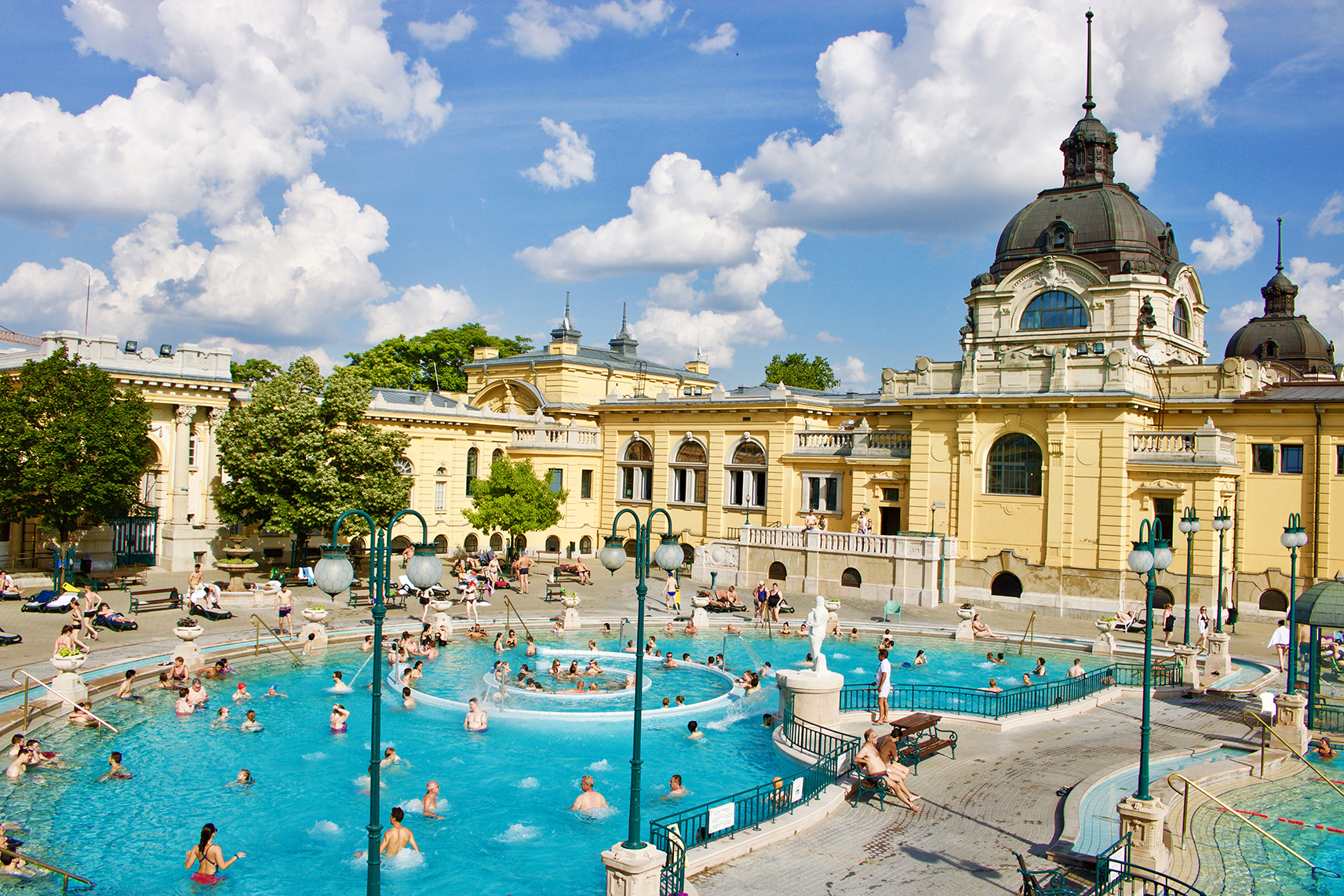Celebrating Széchenyi Thermal Bath and Hungarian Spa Culture

Photo courtesy of Budapest Spas Plc.
The Széchenyi Thermal Bath has been voted among the best in Europe by the British newspaper website Mirror.co.uk. That accolade transported David Holzer back to the first time he encountered the famous building, and Hungarian spa culture on New Year’s Eve, 2014.
My friends and I had been invited to this country by a Hungarian we’d met at Burning Man, a surrealistic gathering held every year in the United States’ Black Rock Desert. We were here to help him celebrate his birthday on New Year’s Day. None of us had ever been to Budapest before so our generous host was determined to show us the best of the city of his birth.
This mostly involved consuming enormous meals and copious amounts of booze. I fondly remember crawling out of a restaurant on Gozsdu Udvar, a courtyard off Király utca, that combined Jewish and Italian cuisine to devasting effect and may have been called My Yiddische Mama Mia!
After a couple of days of this, our host decided we needed to detox and prepare for more revelry at Széchenyi Thermal Bath.

Fairytale 1st Impressions
As we walked across City Park through frosted trees and over the bridge that crosses the lake, which was frozen solid, under skies so blue they looked painted, Széchenyi appeared. I had no idea what I expected to see. But it certainly wasn’t a lemonish yellow cross between a Disney castle that had seen slightly better days and a wedding cake someone had left out in the rain.
Széchenyi looks the way it does because it was designed in the Neo-Baroque style of the late 19th century. It was built after a character named Vilmos Zsigmondy spent 10 years between 1865 and 1875 drilling a hole beneath City Park to a depth of almost 1,000 meters to reach the thermal water that would supply the spa. Construction began in May 1909 and the spa opened in June 1913. A second thermal spring was discovered in 1938 and this provides a supply of 76ºC (168.8ºF) medicinal water from a depth of 1,246 meters.
Today, with 21 indoor and outdoor pools, Széchenyi is the biggest baths in Europe and the third largest in the world. It also offers 10 saunas and steam cabins and a wide range of medical and wellness services. Apart from being honored by the Mirror, it features regularly in lists of Europe’s best thermal baths. Responding to the latest accolade, Ildikó Szűts, CEO of Budapest Spas, the organization that manages the capital’s baths, told me, “It’s an honor to be included in this prestigious selection.”
But back to 2014, and once we were inside Széchenyi, it was like being in one of Mad King Ludwig of Bavaria’s castles except it smelled strongly of chlorine. But when we made it outside, that first view of bathers in the steaming waters beneath the bulbous spires of the strange castle (including lobster red people playing chess using a board placed on the side of the steps leading down to the water) was a revelation.
That New Year’s Eve, we stayed at Széchenyi until it got dark and the rising clouds of steam were illuminated by powerful floodlights. It was the most magical introduction to Hungarian thermal bath culture I could have wished for.
My partner, who I first met that New Year’s Day 2015, is a dedicated sauna aficionado. After eight years tagging along with her to baths all over Hungary, I’ve come to realize that they’re where you see Hungarians at their most, well, Hungarian. This is particularly the case at what are called “sauna seances,” which are offered at Széchenyi.
Sauna Seance
A sauna seance is a guided program of around 15 minutes led by a qualified sauna master and designed, according to the Széchenyi website, to “maximize and supplement the benefits of the sauna.” Personally, I think the purpose of a sauna seance is to be so peculiar and diverting you forget how insanely hot you are.
If you’re tempted to learn more about becoming a sauna master in Hungary, a good place to start is the Hungarian Sauna Association. A professional, non-profit organization made up of Hungarian sauna masters, this “actively participates in building the sauna master community, bringing together and representing the masters, and helping the professional development of the sauna master members.”
The best sauna masters create highly entertaining diversions. I’ve been in sauna seances where masters have encouraged us to smear strange-smelling unguents and even tomatoes and strawberries over our bodies to a soundtrack of Queen. At one sauna seance, a guy ate his tomato before he realized he was meant to rub it into his belly. Not me, honest.
My favorite sauna master ever is a dude we christened the Iceman. His schtick is to stride into the sauna with an bucket full of ice cubes, handfuls of which he then hurls at the ceiling. When the ice hits the hot air it becomes shockingly hot steam that burns when it comes into contact with your skin. I don’t know if this is good for you but it’s definitely invigorating.
After a sauna seance with the Iceman, we would stumble out of the sauna happy, and relieved, to be alive.
Incidentally, Hungary’s Héviz thermal lake also features in the Mirror’s list. I must confess I had no idea Héviz, not far from the western end of Lake Balaton, even existed. Apparently, it’s the largest swimmable thermal lake in the world with temperatures that reach 38ºC (100.4ºF) in summer. One to add to the list.
Thinking about training as a sauna master? Visit www.magyarszaunaegyesulet.hu. If you’re content to simply enjoy the labyrinthine delights of Széchenyi Thermal Bath, find out more at www.spasbudapest.com. When you visit Széchenyi, make sure to bring flip-flops and a robe along with your swimsuit.
This article was first published in the Budapest Business Journal print issue of January 27, 2023.
SUPPORT THE BUDAPEST BUSINESS JOURNAL
Producing journalism that is worthy of the name is a costly business. For 27 years, the publishers, editors and reporters of the Budapest Business Journal have striven to bring you business news that works, information that you can trust, that is factual, accurate and presented without fear or favor.
Newspaper organizations across the globe have struggled to find a business model that allows them to continue to excel, without compromising their ability to perform. Most recently, some have experimented with the idea of involving their most important stakeholders, their readers.
We would like to offer that same opportunity to our readers. We would like to invite you to help us deliver the quality business journalism you require. Hit our Support the BBJ button and you can choose the how much and how often you send us your contributions.







.jpg)


